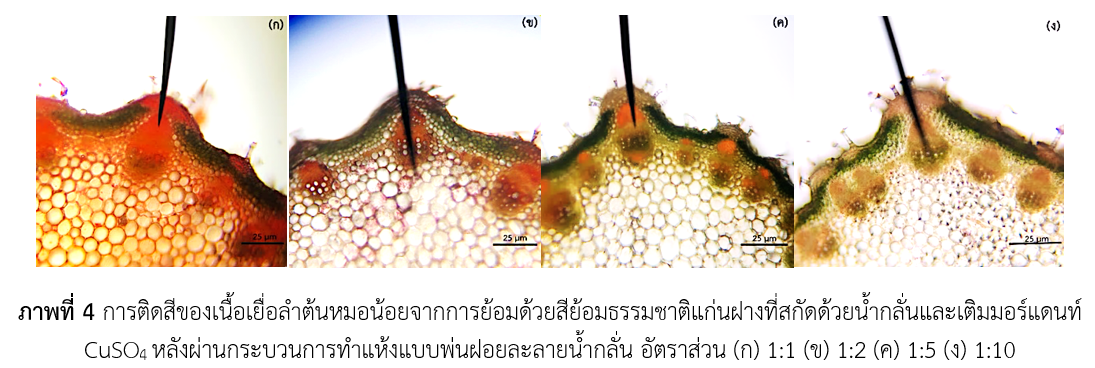การพัฒนาสีย้อมธรรมชาติจากพืชในกลุ่มแอนโทไซยานินเพื่อใช้สำหรับย้อมเนื้อเยื่อพืช
Main Article Content
บทคัดย่อ
การศึกษาเนื้อเยื่อพืชทำได้โดยวิธีการตัดเนื้อเยื่อพืชแบบมือเปล่าและย้อมสีเซลล์เพื่อศึกษาภายใต้กล้องจุลทรรศน์
สีย้อมที่นิยมใช้คือสีซาฟรานินโอซึ่งมีจำหน่ายในราคาสูง จึงมีผู้ศึกษาการสกัดสีย้อมธรรมชาติเพื่อทดแทน แต่เนื่องจากมีข้อจำกัดด้านการใช้งาน เช่น ไม่สะดวกต่อการใช้งาน ไม่สามารถผลิตตามปริมาณที่ต้องการใช้ ยากต่อการเก็บรักษาเพื่อใช้ระยะยาว และไม่สามารถควบคุมคุณภาพการติดสีของตัวอย่างที่ศึกษาได้ ดังนั้นการวิจัยครั้งนี้จึงมีวัตถุประสงค์ในการพัฒนาสีย้อมธรรมชาติจากพืชในกลุ่มแอนโทไซยานินสำหรับย้อมเนื้อเยื่อพืชเพื่อแก้ไขปัญหาด้านข้อจำกัดการใช้สีย้อมธรรมชาติ โดยการคัดเลือกจากส่วนของพืช 3 ชนิด ได้แก่ แก่นฝาง (Biancaea sappan (L.) Tod.) เปลือกมังคุด (Garcinia mangostana L.) และใบประดับเฟื่องฟ้า (Bougainvillea sp.) สกัดด้วย น้ำกลั่น เมททานอล และกรดอะซิติก ร่วมกับการใช้มอร์แดนท์โซเดียมคลอไรด์และคอปเปอร์ซัลเฟต ความเข้มข้น 10% ทดสอบการติดสีย้อมกับลำต้นหมอน้อย (Cyanthillium cinereum (L.) H.Rob)เปรียบเทียบกับสีย้อมซาฟรานินโอความเข้มข้น 0.1% พบว่าสีย้อมจากแก่นฝางที่สกัดด้วยน้ำกลั่นและใช้คอปเปอร์ซัลเฟตเป็นมอร์แดนท์ ให้ผลดีที่สุด มีค่าความเป็นกรด-ด่าง เท่ากับ 2.98 ให้เฉดสีแดง ค่า L* เท่ากับ 25.15 ค่า a* เท่ากับ 24.91 และค่า b* เท่ากับ 18.07 ซึ่งมีความใกล้เคียงกับการย้อมด้วยสีซาฟรานินโอ จากนั้นนำสีย้อมแก่นฝางที่สกัดด้วยน้ำกลั่นและคอปเปอร์ซัลเฟตเป็นมอร์แดนท์มาทำแห้งแบบพ่นฝอย ทดสอบความร้อนขาเข้าที่อุณหภูมิ 210 220 และ 230 องศาเซลเซียส พบว่า อุณหภูมิขาเข้า 210 องศาเซลเซียส เป็นอุณหภูมิที่เหมาะสมที่สุดที่ทำให้น้ำระเหยจากสารสีมีความชื้นในช่วงมาตรฐาน
(7.5 %db) และได้ปริมาณผงสีธรรมชาติมากที่สุด (58.3 %yield) อย่างมีนัยสำคัญทางสถิติที่ระดับ 0.05 จากนั้นหาอัตราส่วนที่เหมาะสมของการละลายผงสีย้อมธรรมชาติในน้ำกลั่น อัตราส่วน 1:1 1:2 1:5 และ 1:10 พบว่าอัตราส่วน 1:1 มีผลต่อการติดสีของเนื้อพืชดีที่สุด เมื่อเปรียบเทียบกับสีย้อมแก่นฝางที่สกัดด้วยน้ำกลั่นและใช้คอปเปอร์ซัลเฟตเป็นมอร์แดนท์ก่อนผ่านการทำแห้งแบบพ่นฝอย โดยมีค่าความเป็นกรด-ด่าง เท่ากับ 3.22 ค่า L* เท่ากับ 22.47 ค่า a* เท่ากับ 20.33 และค่า b* เท่ากับ 16.51 ดังนั้นจึงเห็นควรใช้สีย้อมธรรมชาติแก่นฝางที่สกัดด้วยน้ำกลั่นและเติมมอร์แดนท์คอปเปอร์ซัลเฟตในการย้อมเนื้อเยื่อพืชเพื่อทดแทนสีย้อมสังเคราะห์ซาฟรานินโอ
Article Details

อนุญาตภายใต้เงื่อนไข Creative Commons Attribution-NonCommercial-NoDerivatives 4.0 International License.
วารสารวิทยาศาสตร์และวิทยาศาสตร์ศึกษา (JSSE) เป็นผู้ถือลิสิทธิ์บทความทุกบทความที่เผยแพร่ใน JSSE นี้ ทั้งนี้ ผู้เขียนจะต้องส่งแบบโอนลิขสิทธิ์บทความฉบับที่มีรายมือชื่อของผู้เขียนหลักหรือผู้ที่ได้รับมอบอำนาจแทนผู้เขียนทุกนให้กับ JSSE ก่อนที่บทความจะมีการเผยแพร่ผ่านเว็บไซต์ของวารสาร
แบบโอนลิขสิทธิ์บทความ (Copyright Transfer Form)
ทางวารสาร JSSE ได้กำหนดให้มีการกรอกแบบโอนลิขสิทธิ์บทความให้ครบถ้วนและส่งมายังกองบรรณาธิการในข้อมูลเสริม (supplementary data) พร้อมกับนิพนธ์ต้นฉบับ (manuscript) ที่ส่งมาขอรับการตีพิมพ์ ทั้งนี้ ผู้เขียนหลัก (corresponding authors) หรือผู้รับมอบอำนาจ (ในฐานะตัวแทนของผู้เขียนทุกคน) สามารถดำเนินการโอนลิขสิทธิ์บทความแทนผู้เขียนทั้งหมดได้ ซึ่งสามารถอัพโหลดไฟล์บทความต้นฉบับ (Manuscript) และไฟล์แบบโอนลิขสิทธิ์บทความ (Copyright Transfer Form) ในเมนู “Upload Submission” ดังนี้
1. อัพโหลดไฟล์บทความต้นฉบับ (Manuscript) ในเมนูย่อย Article Component > Article Text
2. อัพโหลดไฟล์แบบโอนลิขสิทธิ์บทความ (Copyright Transfer Form) ในเมนูย่อย Article Component > Other
ดาวน์โหลด ไฟล์แบบโอนลิขสิทธิ์บทความ (Copyright Transfer Form)
เอกสารอ้างอิง
Department of Science Service. (2010). Anthocyanin (In Thai). Bangkok: Bureau of Science and Technology Information.
Genesiska, A. and Herda, R. (2018). Extract of dragon fruit pulp (Hylocereus polyrhizus) potentially stain chromosomes of red onion (Allium ascaloncum). Biogenesis: Journal Ilmiah Biology. 6(2), 93-97.
Gita, H., Zulharmita, Z. and Ridho, A. (2021). Utilization of natural dyes substances for histological staining: a review. Asian Journal of Pharmaceutical Research and Development, 9(1), 149-158.
Hoefnagels, M. (2019). Biology: the essentials. New York: McGraw-Hill Companies, Inc.
Manit, K. (2009). Natural dry from sappan tree (Caesalpinia sappan L.) for studying plant cells and tissues (in Thai). Thai Journal of Botany, 1(2), 61-70.
Mayuree, K., Prawpran, D., Suchaya, W. and Siaporn, H. (2018). Extraction and application of natural dyes from indigenous plants for plant histological staining (In Thai). Proceedings of 3rd North Eastern Science and Technology Conference. (pp.462-471). Ubon Ratchathani: Ubon Ratchathani Rajabhat University.
Phonchai, P. (2018). Productivity improvement of spray drying process in the leather dye manufacturing (in Thai). Master’s Thesis. Bangkok: Kasetsart University.
Rujira, T., Yodchai, C., Alongkod, T. and Sayan, P. (2017). Application of natural dye from purple sweet corn (Zea mays saccharate) for plant cell mitosis studies (in Thai). Koch Cha Sarn Journal of Science, 39(2), 34-44.
Sirirat, P., Naphon, W. and Manussawee, D. (2021). Development of chromosome staining dye extracted from black glutinous rice (Oryza sativa ver. Indica) (In Thai). Burapha Science Journal, 26(2), 1096-1108.
Sobchai, S. (2006). The development of natural dry for staining cell and tissue. Master’s Thesis. Chiang Mai: Chiang Mai University.
Supapporn, P. (2019). Stability of anthocyanin extract from riceberry rice bran encapsulated with rice bran protein concentrate under different pH and heating conditions (in Thai). RMUTSB Academic Journal, 7(2), 205-215.
Suwichar, D. (2007). Extration and purification of anthocyanin from java plum (Syzygium cumini L.) (in Thai). Master’s Thesis. Bangkok: Kasetsart University.


